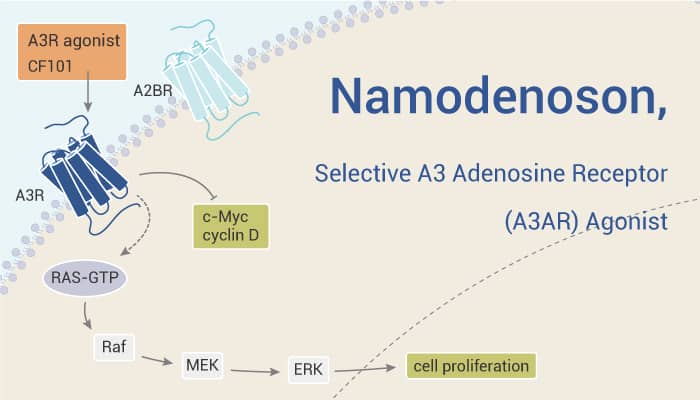The adenosine A3 receptor (A3AR) comes from the cloning from rat, sheep and human sources. In vitro stimulation of this adenosine receptor subtype shows it inhibits adenylyl cyclase. It also stimulates phospholipase C and inositol-1,4,5-triphosphate (IP3) will form. In vivo activation of the A3 receptor, it also mediates heart rate-independent hypotension in rats, vasoconstriction and depression of locomotor activity in mice.
Moreover, the A3 receptor is enigmatic in terms of antagonist ligand specificity, coupling to second messengers, and biological effects in the CNS, inflammatory system and cardiovascular system. A3 receptors are also potentially involved in apoptosis. It appears that intense, acute activation of A3 receptors acts as a lethal input to cells, while low concentrations of A3 receptor agonists protect against apoptosis. Furthermore, A3 receptor agonists might be useful in researching inflammatory conditions. It is possible through their inhibition of tumor necrosis factor-alpha (TNF-alpha) release. A3 receptor antagonists might be useful in treating asthma or acute brain ischemia.
Although selective agonists for the A1 and A2A receptors have been available for several years, highly selective A3 receptor agonists have been synthesized only recently. 2-Chloro-N6-(3-iodobenzyl) adenosine-5′-N-methyl-carboxamide (CF-102) is the first highly selective adenosine A3 receptor agonist.
Namodenoson (CF-102) is a selective A3 adenosine receptor (A3AR) agonist (Ki=0.33 nM).
Namodenoson displays 2500- and 1400-fold selectivity over A1 and A2A receptors respectively. In human ADF cells of astroglial lineage, 100 nM Namodenoson (CF-102) causes a marked reorganization of the cytoskeleton, with appearance of stress fibres and numerous cell protrusions. High concentrations of Namodenoson (CF-102) also directly cause influx of Ca2+.
Furthermore, intravenous administration of 200 μg/kg Namodenoson (CF-102) results in short-lasting hypotension, while plasma histamine concentrations increase almost 50-100-fold. Administration of the second dose of Namodenoson (CF-102) does not elicit any hemodynamic effects.
In conclusion, Namodenoson (CF-102) has the potential for the research of asthma or acute brain ischemia.
Reference:
[1]. Jacobson KA. Adenosine A3 receptors: novel ligands and paradoxical effects.
[2].Van Schaick EA, et al. . 1996 Jul 25;308(3):311-4.